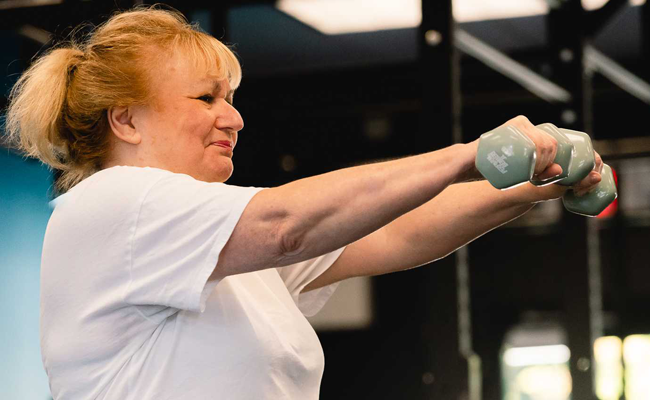Osteoporosis is a condition that affects around 20% of women over 50 and is common among older adults. As people age, their bones can become less dense and more vulnerable to damage.
While treatments are available, prevention through targeted strength training is the best approach. A strength training program for osteoporosis can help build muscle, strengthen bones and improve overall health.
This can be highly beneficial in preventing or improving symptoms of osteoporosis. Such training programs include muscle-strengthening exercises like deadlifts, lunges, and squats, which help to exert force on the bones, making them stronger and denser.
Let’s discover the advantages of participating in a strength training program to prevent or improve osteoporosis symptoms.
Who Can Get Osteoporosis?

Osteoporosis can affect all ages and genders, but mostly older women, due to the hormonal changes that occur during menopause.
A combination of genetic predisposition, lifestyle choices, diet, smoking, and drinking habits can all increase the likelihood of developing osteoporosis.
Even a healthy lifestyle does not provide complete protection against the disease, especially for those who have an existing predisposition. While swimming, walking, and biking are great for overall health, they do not provide enough weight-bearing stimulus to fully protect against osteoporosis.
Those with existing bone injuries or disorders, such as arthritis, also have an elevated risk of osteoporosis. Knowing these risks can help individuals make informed decisions about prevention through regular weight-bearing exercises, proper nutrition, and stress management.
Don’t wait any longer to start feeling better, healing, preventing injury, and reaching your movement goals. Let the professionals at Kaari help you today!
Why strength training is important for Osteoporosis Prevention?
Resistance exercises stimulate the cells that create bone mass, reduce bone porosity, and make bones stronger.
Incorporating balance-enhancing elements into regular strength training can also be effective in reducing your risk of falls. Good balance exercise is crucial for individuals with osteoporosis, as falls are a common cause of bone fractures in older adults.
In addition, exercise strengthens the muscles around the joints and provides more support for the skeletal system, helping to maintain good posture as one ages.
A stooped posture, commonly seen in elderly osteoporosis patients, can cause spinal fractures due to uneven weight distribution on the vertebral bones.
Benefits of Strength Training for Osteoporosis Prevention
There are several benefits that strength and resistance training provide, especially in preventing osteoporosis. Let’s take a look at each in detail.
Strength Training Can Slow Bone Loss and Build Bones
Over time, an imbalance between osteoclasts (cells that absorb bone) and osteoblasts (cells that form bone) can result in porous and fragile bones. When osteoclast activity is high, it leads to an increased rate of porous bones.
Bones are living structures and adapt to the way they are loaded. Strength training is an effective way to prevent osteoporosis as it loads strains the bones, encouraging them to strengthen.
By engaging in proper training, you can significantly reduce the bone loss that occurs with age, menopause, or other underlying conditions. When done correctly and consistently, strength training can provide protective benefits to those at risk, helping to maintain musculoskeletal health.
Muscle strength, balance, and coordination
Strength training is not just important for maintaining bone density; it’s also crucial for building muscle. Increased muscle strength leads to improved posture and greater endurance in daily life. Strong muscles also reduce the risk of injury by providing better support to bones and joints.
These high-impact exercises that focus on improving balance can help lower the risk of falls, a common cause of fractures among older adults. These injuries are often seen in the wrist, hip, lower spine, and long bones in the legs.
Maintaining good balance is key to overall health and independence as you age. The strength training regimen to ensure this balance does not have to be overly intense. Low-impact resistance exercises done correctly and consistently using light to medium dumbbells can also be effective.
Strength training improves posture.
A stooped, forward-bent posture sometimes characterizes osteoporosis in older adults. This not only causes people to appear smaller but also causes a reduction in actual height. This is caused by weakened muscles that cannot support a good, upright posture.
The hunched-over posture puts uneven pressure on the spinal vertebrae, leading to bone spikes growing in the stressed areas. If these spikes break off, the resulting vertebral fractures are a common cause of back pain.
Strength exercises improve bone strength and lead to better posture, which is especially important for those with reduced bone density. By training with proper technique and under the supervision of an osteoporosis-informed coach also creates a positive feedback cycle.
The exercise helps boost energy levels and improves overall functionality, making staying active and maintaining health easier. When posture is concerned, strength training can be especially effective when combined with forms like stretching and yoga.
Prevents the Future Occurrence of Bone Loss
Strength training is an important aspect of managing and preventing osteoporosis. Whether or not you have been diagnosed with osteoporosis, incorporating strength training into your exercise routine can greatly reduce your risk of developing the condition.
It is recommended to talk to a professional for a safe and effective strength training program that is tailored to your specific needs.
Boosts Self-Confidence
Being diagnosed with Osteoporosis can be very devastating. The awareness that you can no longer do most things you used to do makes you lose appreciation for your body.
Some patients of Osteoporosis have shared their experiences and how they began feeling less confident and avoiding social interactions.
Strength training would increase body mass and build trust and love for your body again. You can go further to do your daily task and interact with people without fear and embarrassment.
How to Prevent Osteoporosis?
There are several steps you can take to prevent osteoporosis:
- Get Enough Calcium and Vitamin D: These nutrients are essential for building and maintaining healthy bones. Great sources of calcium include dairy products, leafy green vegetables, and calcium-fortified foods. Vitamin D can be obtained from sunlight, fatty fish, and fortified foods.
- Exercise Regularly: Weight-bearing and resistance exercises, such as weightlifting, help to build and maintain bone mass. Aim for at least 30 minutes of weight-bearing exercise most days of the week.
- Smoking or drinking can decrease bone density, while excessive alcohol consumption can interfere with the body’s ability to absorb calcium and vitamin D.
- Maintain a Healthy Diet: Eating a balanced diet rich in fruits, vegetables, and protein can help support bone health.
- Consider a Bone Density Test: Getting a bone density test can help to identify early signs of osteoporosis. If you are at risk, your healthcare provider may recommend treatment options.
- Consider Medication: Medication can help slow down bone loss if lifestyle changes aren’t enough. Have a talk with your doctor about the potential need for meds.
- Practice Balance and Fall Prevention Exercises: The risk of falls increases with age and can cause fractures, especially in the case of osteoporosis.
Can you reverse osteoporosis?
Although there is currently no cure for osteoporosis, there are still ways to manage the condition and improve bone health. A regular regimen of strength training and weight-bearing exercises can help to rebuild and strengthen bones. These types of exercise have been scientifically proven to stimulate new bone growth and slow down bone loss.
One program designed specifically for people with osteoporosis is Kaari Prehab’s strength training and yoga program. This program aims to increase bone density and strength in commonly affected areas of the body and restore mobility and flexibility for better long-term function as they offer the best program!
Conclusion
Strength training can be an effective way to alleviate symptoms of osteoporosis. It can increase bone density, improve balance and coordination, and build muscle mass. Plus, it’s a fitness option suitable for people of all ages and body weights.
If you’re looking to begin a strength training program, Kaari Prehab can help. They offer personalized strength training services for individuals diagnosed with osteoporosis and those who want to proactively take care of their bone health. Contact them to learn more about how they can help you achieve better health.




